2021 HYUNDAI ELANTRA HYBRID tires
[x] Cancel search: tiresPage 504 of 555
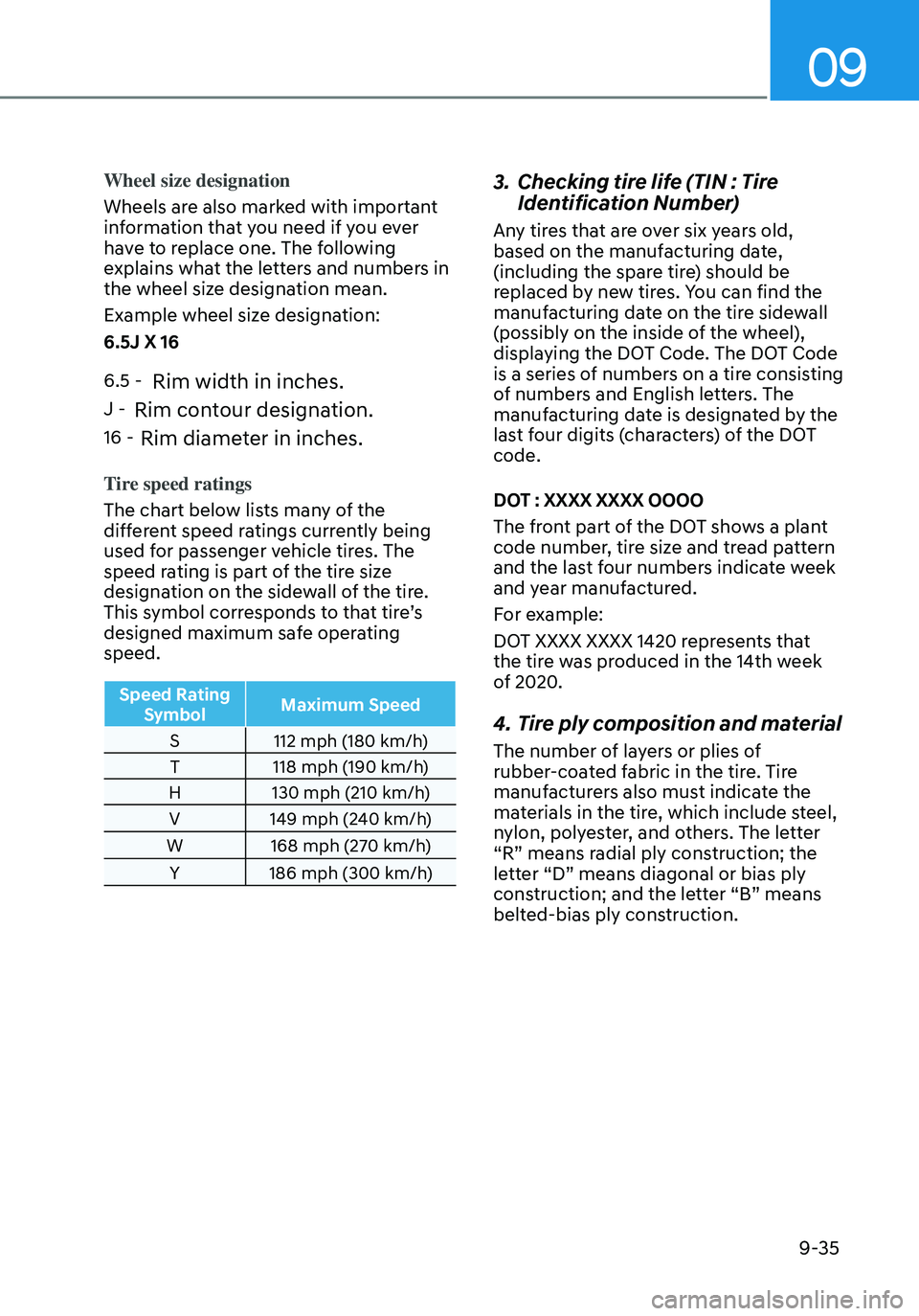
09
9-35
Wheel size designation
Wheels are also marked with important
information that you need if you ever
have to replace one. The following
explains what the letters and numbers in
the wheel size designation mean.
Example wheel size designation:
6.5J X 16
6.5 -
Rim width in inches.
J -Rim contour designation.
16 -Rim diameter in inches.
Tire speed ratings
The chart below lists many of the
different speed ratings currently being
used for passenger vehicle tires. The
speed rating is part of the tire size
designation on the sidewall of the tire.
This symbol corresponds to that tire’s
designed maximum safe operating
speed.
Speed Rating Symbol Maximum Speed
S 112 mph (180 km/h)
T 118 mph (190 km/h)
H 130 mph (210 km/h)
V 149 mph (240 km/h)
W 168 mph (270 km/h)
Y 186 mph (300 km/h)
3. Checking tire life (TIN : Tire
Identification Number)
Any tires that are over six years old,
based on the manufacturing date,
(including the spare tire) should be
replaced by new tires. You can find the
manufacturing date on the tire sidewall
(possibly on the inside of the wheel),
displaying the DOT Code. The DOT Code
is a series of numbers on a tire consisting
of numbers and English letters. The
manufacturing date is designated by the
last four digits (characters) of the DOT
code.
DOT : XXXX XXXX OOOO
The front part of the DOT shows a plant
code number, tire size and tread pattern
and the last four numbers indicate week
and year manufactured.
For example:
DOT XXXX XXXX 1420 represents that
the tire was produced in the 14th week
of 2020.
4. Tire ply composition and material
The number of layers or plies of
rubber-coated fabric in the tire. Tire
manufacturers also must indicate the
materials in the tire, which include steel,
nylon, polyester, and others. The letter
“R” means radial ply construction; the
letter “D” means diagonal or bias ply
construction; and the letter “B” means
belted-bias ply construction.
Page 505 of 555
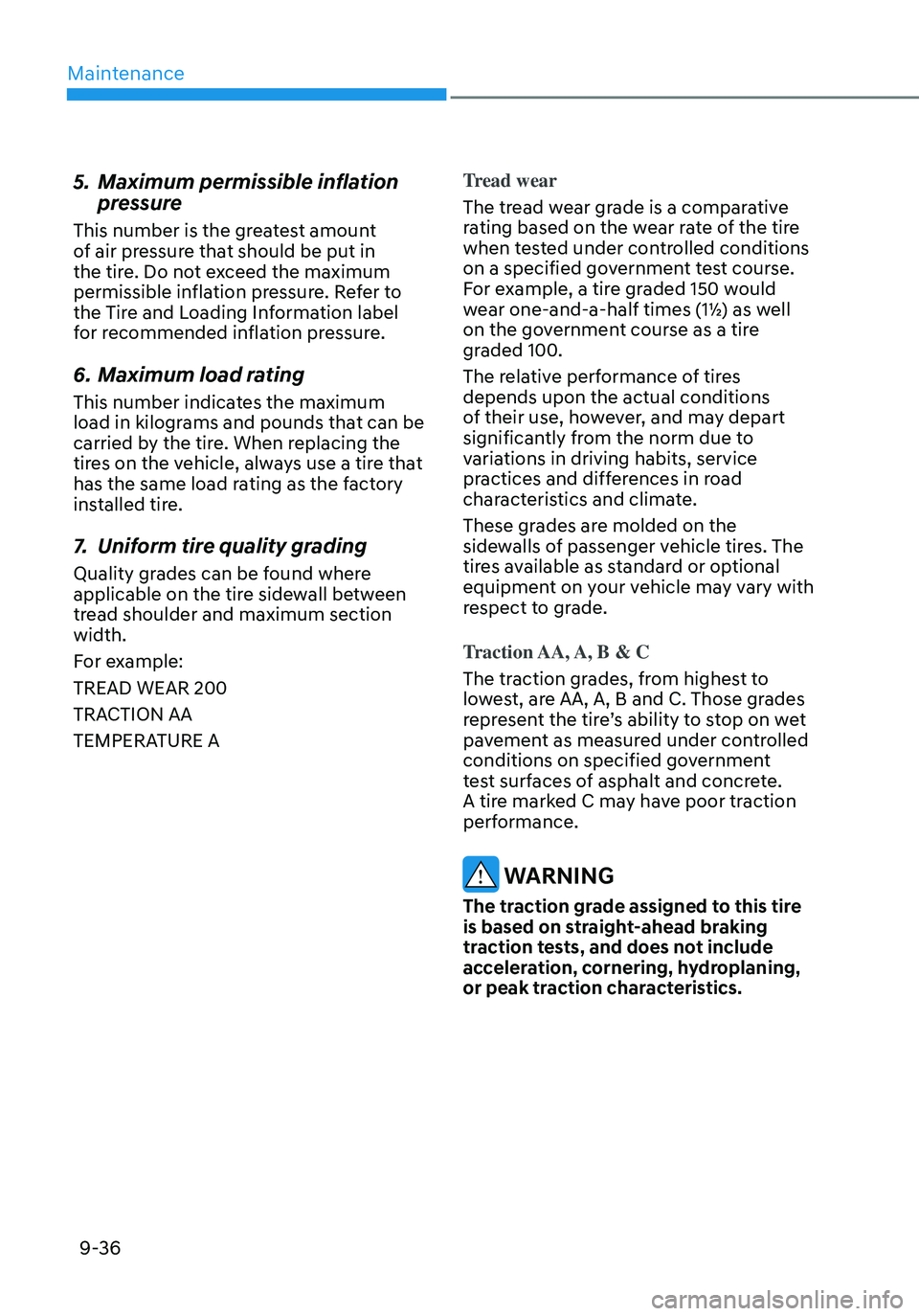
Maintenance
9-36
5. Maximum permissible inflation
pressure
This number is the greatest amount
of air pressure that should be put in
the tire. Do not exceed the maximum
permissible inflation pressure. Refer to
the Tire and Loading Information label
for recommended inflation pressure.
6. Maximum load rating
This number indicates the maximum
load in kilograms and pounds that can be
carried by the tire. When replacing the
tires on the vehicle, always use a tire that
has the same load rating as the factory
installed tire.
7. Uniform tire quality grading
Quality grades can be found where
applicable on the tire sidewall between
tread shoulder and maximum section
width.
For example:
TREAD WEAR 200
TRACTION AA
TEMPERATURE ATread wear
The tread wear grade is a comparative
rating based on the wear rate of the tire
when tested under controlled conditions
on a specified government test course.
For example, a tire graded 150 would
wear one-and-a-half times (1½) as well
on the government course as a tire
graded 100.
The relative performance of tires
depends upon the actual conditions
of their use, however, and may depart
significantly from the norm due to
variations in driving habits, service
practices and differences in road
characteristics and climate.
These grades are molded on the
sidewalls of passenger vehicle tires. The
tires available as standard or optional
equipment on your vehicle may vary with
respect to grade.
Traction AA, A, B & C
The traction grades, from highest to
lowest, are AA, A, B and C. Those grades
represent the tire’s ability to stop on wet
pavement as measured under controlled
conditions on specified government
test surfaces of asphalt and concrete.
A tire marked C may have poor traction
performance.
WARNING
The traction grade assigned to this tire
is based on straight-ahead braking
traction tests, and does not include
acceleration, cornering, hydroplaning,
or peak traction characteristics.
Page 506 of 555
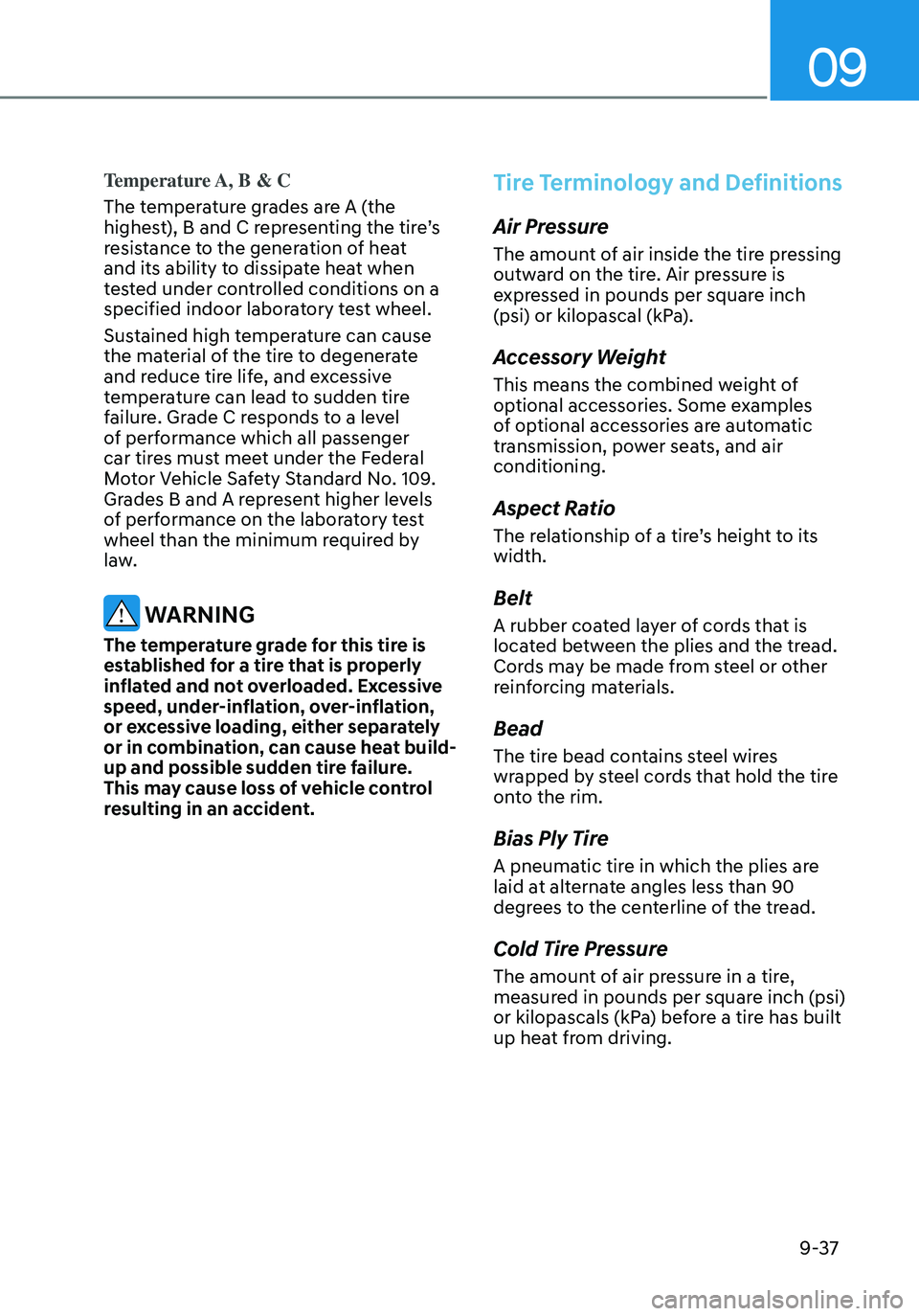
09
9-37
Temperature A, B & C
The temperature grades are A (the
highest), B and C representing the tire’s
resistance to the generation of heat
and its ability to dissipate heat when
tested under controlled conditions on a
specified indoor laboratory test wheel.
Sustained high temperature can cause
the material of the tire to degenerate
and reduce tire life, and excessive
temperature can lead to sudden tire
failure. Grade C responds to a level
of performance which all passenger
car tires must meet under the Federal
Motor Vehicle Safety Standard No. 109.
Grades B and A represent higher levels
of performance on the laboratory test
wheel than the minimum required by
law.
WARNING
The temperature grade for this tire is
established for a tire that is properly
inflated and not overloaded. Excessive
speed, under-inflation, over-inflation,
or excessive loading, either separately
or in combination, can cause heat build-
up and possible sudden tire failure.
This may cause loss of vehicle control
resulting in an accident.
Tire Terminology and Definitions
Air Pressure
The amount of air inside the tire pressing
outward on the tire. Air pressure is
expressed in pounds per square inch
(psi) or kilopascal (kPa).
Accessory Weight
This means the combined weight of
optional accessories. Some examples
of optional accessories are automatic
transmission, power seats, and air
conditioning.
Aspect Ratio
The relationship of a tire’s height to its
width.
Belt
A rubber coated layer of cords that is
located between the plies and the tread.
Cords may be made from steel or other
reinforcing materials.
Bead
The tire bead contains steel wires
wrapped by steel cords that hold the tire
onto the rim.
Bias Ply Tire
A pneumatic tire in which the plies are
laid at alternate angles less than 90
degrees to the centerline of the tread.
Cold Tire Pressure
The amount of air pressure in a tire,
measured in pounds per square inch (psi)
or kilopascals (kPa) before a tire has built
up heat from driving.
Page 509 of 555
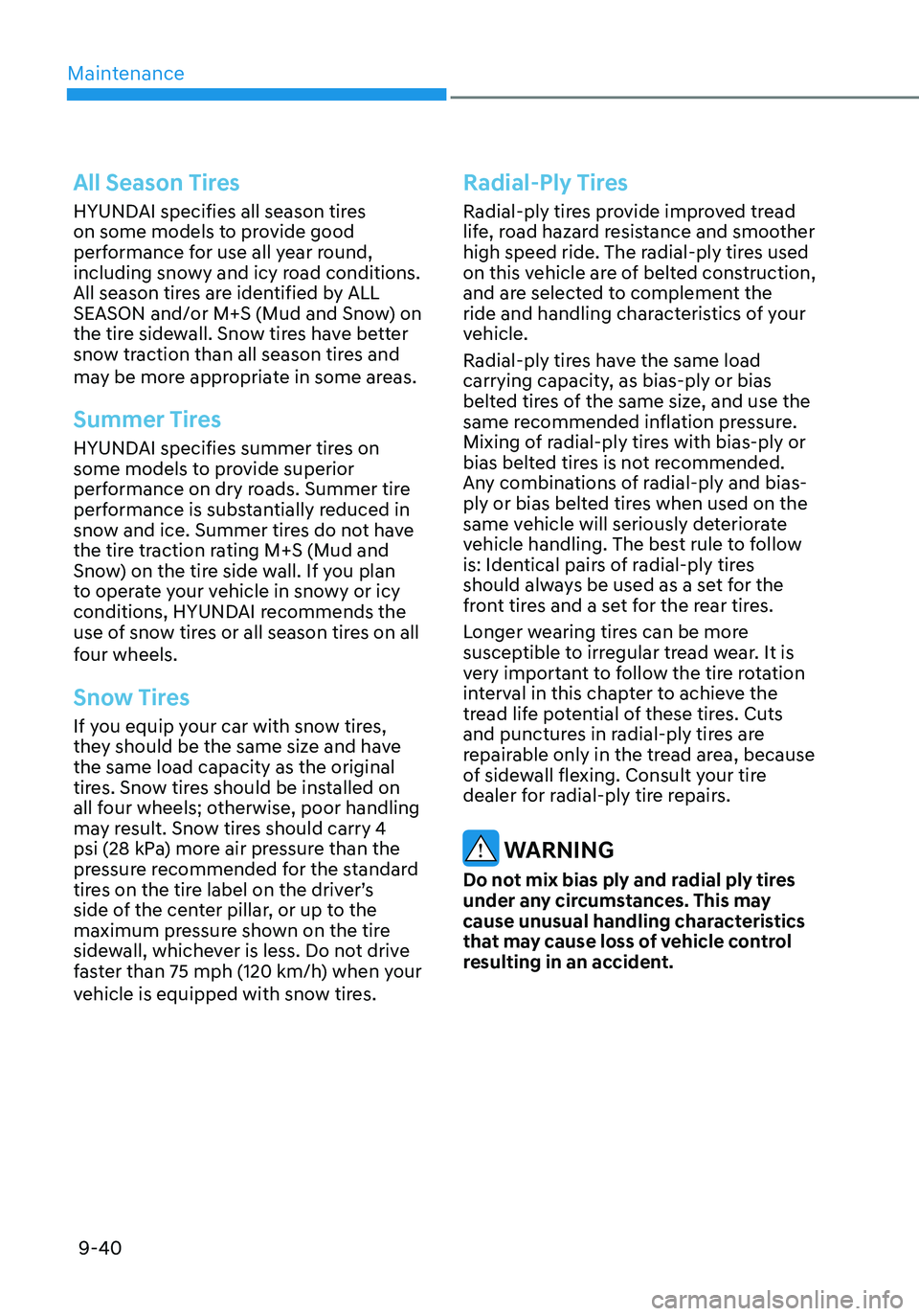
Maintenance9-40
All Season Tires
HYUNDAI specifies all season tires
on some models to provide good
performance for use all year round,
including snowy and icy road conditions.
All season tires are identified by ALL
SEASON and/or M+S (Mud and Snow) on
the tire sidewall. Snow tires have better
snow traction than all season tires and
may be more appropriate in some areas.
Summer Tires
HYUNDAI specifies summer tires on
some models to provide superior
performance on dry roads. Summer tire
performance is substantially reduced in
snow and ice. Summer tires do not have
the tire traction rating M+S (Mud and
Snow) on the tire side wall. If you plan
to operate your vehicle in snowy or icy
conditions, HYUNDAI recommends the
use of snow tires or all season tires on all
four wheels.
Snow Tires
If you equip your car with snow tires,
they should be the same size and have
the same load capacity as the original
tires. Snow tires should be installed on
all four wheels; otherwise, poor handling
may result. Snow tires should carry 4
psi (28 kPa) more air pressure than the
pressure recommended for the standard
tires on the tire label on the driver’s
side of the center pillar, or up to the
maximum pressure shown on the tire
sidewall, whichever is less. Do not drive
faster than 75 mph (120 km/h) when your
vehicle is equipped with snow tires.
Radial-Ply Tires
Radial-ply tires provide improved tread
life, road hazard resistance and smoother
high speed ride. The radial-ply tires used
on this vehicle are of belted construction,
and are selected to complement the
ride and handling characteristics of your
vehicle.
Radial-ply tires have the same load
carrying capacity, as bias-ply or bias
belted tires of the same size, and use the
same recommended inflation pressure.
Mixing of radial-ply tires with bias-ply or
bias belted tires is not recommended.
Any combinations of radial-ply and bias-
ply or bias belted tires when used on the
same vehicle will seriously deteriorate
vehicle handling. The best rule to follow
is: Identical pairs of radial-ply tires
should always be used as a set for the
front tires and a set for the rear tires.
Longer wearing tires can be more
susceptible to irregular tread wear. It is
very important to follow the tire rotation
interval in this chapter to achieve the
tread life potential of these tires. Cuts
and punctures in radial-ply tires are
repairable only in the tread area, because
of sidewall flexing. Consult your tire
dealer for radial-ply tire repairs.
WARNING
Do not mix bias ply and radial ply tires
under any circumstances. This may
cause unusual handling characteristics
that may cause loss of vehicle control
resulting in an accident.
Page 510 of 555
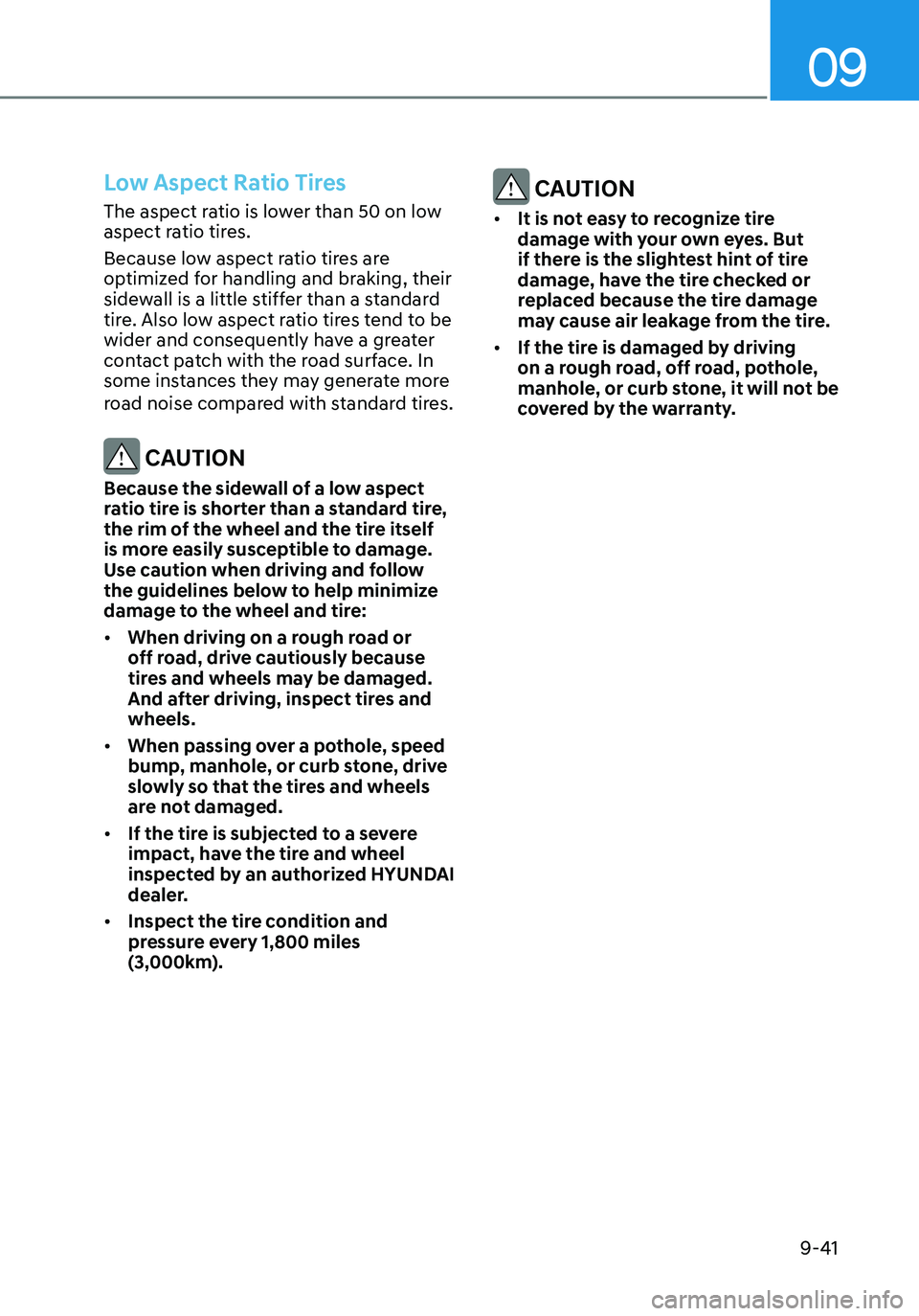
09
9-41
CAUTION
• It is not easy to recognize tire
damage with your own eyes. But
if there is the slightest hint of tire
damage, have the tire checked or
replaced because the tire damage
may cause air leakage from the tire.
• If the tire is damaged by driving
on a rough road, off road, pothole,
manhole, or curb stone, it will not be
covered by the warranty.
Low Aspect Ratio Tires
The aspect ratio is lower than 50 on low
aspect ratio tires.
Because low aspect ratio tires are
optimized for handling and braking, their
sidewall is a little stiffer than a standard
tire. Also low aspect ratio tires tend to be
wider and consequently have a greater
contact patch with the road surface. In
some instances they may generate more
road noise compared with standard tires.
CAUTION
Because the sidewall of a low aspect
ratio tire is shorter than a standard tire,
the rim of the wheel and the tire itself
is more easily susceptible to damage.
Use caution when driving and follow
the guidelines below to help minimize
damage to the wheel and tire:
• When driving on a rough road or
off road, drive cautiously because
tires and wheels may be damaged.
And after driving, inspect tires and
wheels.
• When passing over a pothole, speed
bump, manhole, or curb stone, drive
slowly so that the tires and wheels
are not damaged.
• If the tire is subjected to a severe
impact, have the tire and wheel
inspected by an authorized HYUNDAI
dealer.
• Inspect the tire condition and
pressure every 1,800 miles
(3,000km).
Page 548 of 555

Index
I-6
G
Guide to Hyundai Genuine Parts
........................................................................\
...1-3
H
Hazard Warning Flasher
........................................................................\
................8-2
HEV (Hybrid Electric Vehicle) System
.................................................................1-9
High Beam Assist (HBA)
........................................................................\
............5-76
Detecting sensor (Front view camera) .............................................................5-76
Function malfunction and limitations ..............................................................5-77
Function operation ........................................................................\
....................5-77
Function settings ........................................................................\
......................5-76
Highway Driving Assist (HDA)
........................................................................\
.7-92
Function malfunction and limitations ..............................................................7-96
Function operation ........................................................................\
....................7-94
Function settings ........................................................................\
......................7-93
Hood
........................................................................\
............................................5-62
How to Use This Manual
........................................................................\
...............1-4
Hybrid Starter & Generator (HSG) Belt
..............................................................9-22
Checking the Hybrid Starter & Generator (HSG) Belt ....................................9-22
Hyundai Motor America
........................................................................\
................1-2
I
If the 12 Volt Battery Is Discharged
......................................................................8-4
Before Jump Starting ........................................................................\
..................8-4
Jump Starting........................................................................\
.............................. 8-5
If the Engine Overheats
........................................................................\
.................8-7
If the Engine Will Not Start
........................................................................\
...........8-3
If you Have a Flat Tire (With spare tire)
.............................................................8-15
Changing Tires ........................................................................\
.........................8-16
Jack and Tools ........................................................................\
..........................8-15
Ignition Switch
........................................................................\
..............................6-4
Engine Start/Stop Button ........................................................................\
............6-7
Key Ignition Switch ........................................................................\
...................6-4
Important Safety Precautions
........................................................................\
.........3-2
Air Bag Hazards ........................................................................\
.........................3-2
Always Wear Your Seat Belt ........................................................................\
......3-2
Control Your Speed ........................................................................\
....................3-2
Driver Distraction ........................................................................\
.......................3-2
Page 553 of 555

I
I-11
Highway Driving ........................................................................\
......................6-44
Rocking the Vehicle........................................................................\
..................6-42
Smooth Cornering ........................................................................\
....................6-43
Steering Wheel
........................................................................\
.............................5-41
Electric Power Steering (EPS) ........................................................................\
.5-41
Horn ........................................................................\
..........................................5-43
Tilt Steering / Telescope Steering .....................................................................5-42
Storage compartment
........................................................................\
.................5-102
Center console storage ........................................................................\
...........5-102
Glove box ........................................................................\
...............................5-102
Sunroof
........................................................................\
........................................5-58
Resetting the sunroof ........................................................................\
................5-61
Sunroof open warning ........................................................................\
..............5-61
Sunroof opening and closing ........................................................................\
....5-59
Sunshade........................................................................\
................................... 5-60
Tilting the sunroof ........................................................................\
....................5-60
T
Theft –Alarm System
........................................................................\
...................5-37
Tire Pressure Monitoring System (TPMS)
...........................................................8-9
Changing a tire with TPMS ........................................................................\
......8-13
Check tire pressure ........................................................................\
.....................8-9
Low tire pressure position and tire pressure telltale .........................................8-11
Low tire pressure telltale ........................................................................\
..........8-11
Tire pressure monitoring system ......................................................................8-10
TPMS (Tire Pressure Monitoring System) malfunction indicator ...................8-13
Tire Specification and Pressure Label
.................................................................2-14
Tires and Wheels
........................................................................\
.................2-9/ 9-29
All Season Tires ........................................................................\
.......................9-40
Check Tire Inflation Pressure ........................................................................\
...9-30
Low Aspect Ratio Tires ........................................................................\
............9-41
Radial-Ply Tires ........................................................................\
........................9-40
Recommended Cold T ire Inflation Pressures ...................................................9-29
Snow Tires ........................................................................\
................................9-40
Summer Tires ........................................................................\
...........................9-40
Tire Care ........................................................................\
...................................9-29
Tire Maintenance ........................................................................\
......................9-34
Tire Replacement ........................................................................\
.....................9-32
Tire Rotation ........................................................................\
.............................9-31